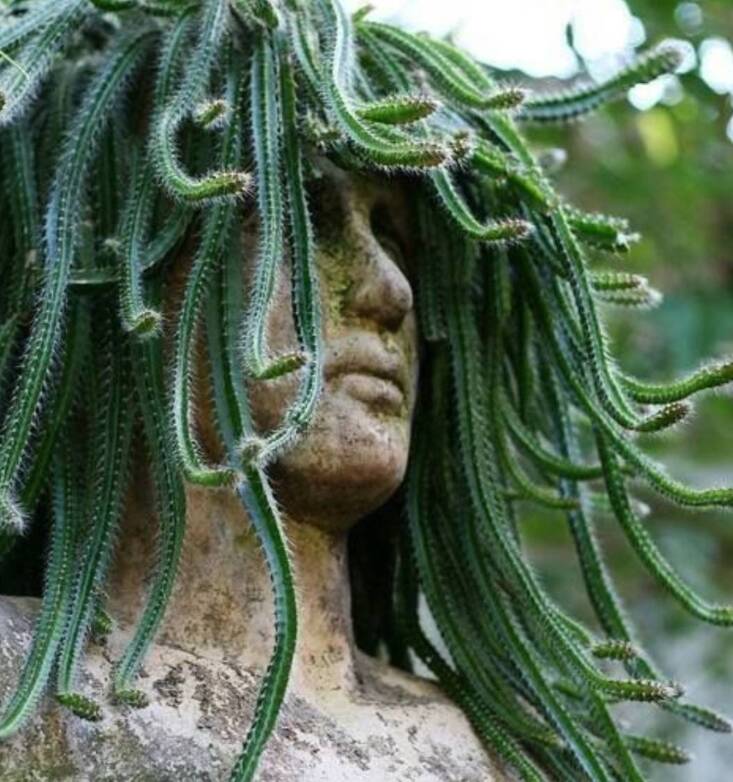Dog tail cactus: Selenicereus testudo
Fine, I’ll admit it. As a dog-lover, most things with the word ‘dog’ in it will draw my attention. But this plant really does have more to it than just a canine reference. Dog tail cactus is strangely exotic-looking, with its long, tail-like cylindrical stems dotted with tiny spines that cascade like a dangerous waterfall. Plus, this cactus is relatively carefree and, fortunately, doesn’t require walks around the block.
Please keep reading to learn more about your new canine cactus friend:

Native to the tropical rainforests of South America, dog tail cactus is epiphytic, meaning in its native habitat it is found living on and winding around large trees. It is also polymorphic, meaning its stems change shape and broaden as it gets older. This cactus can also grow to a surprising 6 to 9 feet tall but most won’t experience that stature.
Dog tail cactus can survive where temperatures hover between 40 degrees and 85 degrees F, which means it won’t stand frosty nights. This also means most people grow this unique cactus indoors so that the required light, humidity, and temperature requirements can be met. Like most cactus, it needs heat and light but, like Goldilocks, it has to be the right amount or it won’t be happy.

Don’t get the wrong impression though. In general this is an easy-to-grow cactus. Just make sure you set it up for success by planting it in fast, well-draining soil. Also, this cactus doesn’t like excess water, so consider using a terracotta pot over a glazed container as clay helps absorb excess moisture which will reduce the threat of root rot. And always make sure your pot has drain holes.
From time to time, this plant can be confused with the rat tail cactus which looks similar. (Note: I am not drawn to things with the word ‘rat’ in it.) The main difference is that the rat tail cactus produces late spring orange or pink flowers and is more drought- and sun-tolerant than the dog tail.
Cheat Sheet

- Because of its trailing habit, dog tail cactus is perfect for perching on shelves and pedestals or, of course, in hanging baskets.
- Stems are lined with sharp spines, so keep this plant away from small children, curious pets, or clumsy adults.
- Top dress with small gravel so the water won’t collect near the stems and cause possible rot.
- Pretty white orchid-like blooms emerge in the summer months at nighttime, but only if enough light has been provided.
Keep It Alive

- Fast, well-draining soil is critical. Use a pre-made cactus mix or consider making your own mix: use two parts sand, fine gravel or perlite mixed with one part organic matter.
- This cactus likes more moisture during the summer ,but it always needs to drain away sufficiently. Pro Tip: stick your finger into the soil and if the top 3 inches are dry, then it’s time to give your cactus a thorough drink. If ever your cactus looks wilted, it’s probably from too much water.
- Indoors, provide a sustained amount of bright light but not scorching direct sun. One foot or less away from a south facing window is ideal. If light is insufficient, then the stems become weak and pale and the spines soften and become more hair-like. If growing outdoors, part sun or dappled light is preferred.
- If you repot your cactus when it outgrows its pot, then you can forgo any fertilizer. When repotting, make sure the soil is dry, gently shake off any old soil and check to see if any roots are dead or rotted and remove those before replanting in fresh soil. Warning: wear protective gloves to avoid an accidental acupuncture session by an untrained cactus.
- Try propagating this cactus by stem cuttings. Always make sure your plant is healthy first. In the spring, use a sharp clean knife and cut a stem at the joint and then wait for the end to dry out and callus over. This may take a few days. Then make sure your small pot has well-draining soil that is barely damp. Slightly bury your cutting (about 1-2 inches). Keep the soil damp until roots form then resume normal watering.
For more cactuses we like, see:









Have a Question or Comment About This Post?
Join the conversation